Mobility and rehabilitation
Lower limb amputation
What is rehabilitation?
Rehabilitation is the therapy or training you complete after a time of illness
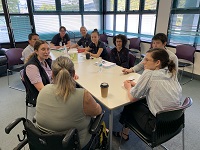
or surgery. Rehabilitation is a team effort, with you at the centre of the team. The Rehabilitation Team helps you get back to daily life. They provide support and therapy for your physical, emotional, thinking and learning needs.
After lower limb amputation surgery, one of these needs will be your mobility.
For further information please view the major lower limb rehabilitation brochure
Mobility rehabilitation with a wheelchair
It is important that you have a way of getting out of bed in the first few days after your surgery, as this helps prevent general complications of

surgery and helps your recovery.
Your healthcare team may use special ways for you to get in and out of bed; and move from your bed to a chair. A wheelchair will be selected for you, and consider your size, your balance, and care of your residual limb.
The team will teach you skills to use the wheelchair safely.
They will work with you on how to return to home or another accommodation using a wheelchair.
Guidance will be provided on equipment funding options and any home modifications you are likely to need if returning home.
Prosthetic suitability
Rehabilitation teams assess whether a prosthesis is suitable for you.
Some of the considerations include:
- Age and health conditions
- Physical abilities
- Thinking and cognitive abilities
- Condition of your remaining limbs
- Psychological factors
- Social supports
Rehabilitation team members will talk to you about your goals and what type of rehabilitation might be right for you. A prosthetic leg is not suitable for everyone. The decision for a non-prosthetic rehabilitation path is made together with the Rehabilitation Team.
Wheelchair or other mobility might suit your needs and goals more than a prosthetic leg.
Rehabilitation with a wheelchair
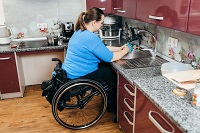
Rehabilitation will focus on you achieving independence with mobility and self-care, using a wheelchair or other form of aid.
Rehabilitation might include:
- Learning to use a wheelchair
- Home exercise
- Learning new ways to complete activities of daily living
- Community access and mobility
- Emotional support and well-being
Cosmetic prosthesis
Your healthcare team may suggest a cosmetic leg.
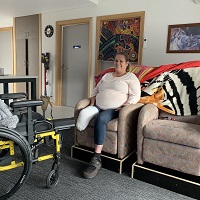
A cosmetic leg is only used in a seated position.
It fills the trouser leg on the amputated side and restores physical appearance.
This may be important for you.
Long-term wheelchair use
Adjusting to life after amputation can be challenging.
It is important to get back to the things you enjoy in life and find your ‘new normal’.
Members of your health care team will be able to provide advice on access about your home and community using a wheelchair.
For further information please view the wheelchair mobility brochure
Mobility rehabilitation with a prosthetic leg
Prosthetic rehabilitation may be commenced as a hospital inpatient or a community outpatient.
Most prosthetic rehabilitation in Tasmania occurs as a community outpatient.
Inpatient rehabilitation
You will stay in a hospital rehabilitation ward to progress your rehabilitation goals.

You will work with physiotherapy, occupational therapy, prosthetics, and other team members. The team will determine when you are safe for discharge home.
Outpatient rehabilitation
Rehabilitation continues as an outpatient, in your home and in your community. You work towards your goals for walking with a prosthesis. The team will determine when it is safe for you to take your prosthetic leg home.
Using a prosthesis is quite different from normal walking and has limitations. Successful prosthetic use requires your significant commitment to rehabilitation.
Your first prosthesis
The 'interim prosthesis' is your first prosthesis. You learn to stand and walk with an interim prosthesis.
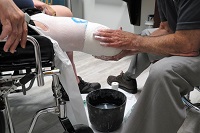
As your body heals, your residual limb undergoes many changes. Changes include shrinking (or ‘volume reduction’), scar healing, muscle loss and changing shape. Change continues for up to twelve months, sometimes longer. The interim prosthesis needs regular adjustment to fit the residual limb. You may need more than one ‘interim’ prosthesis before you are ready for a ‘definitive' prosthesis. It can be made differently to suit your needs.
Learning to use a prosthetic leg
Learning to use a prosthetic leg is different for everyone. The time it takes to be safe and confident with a prosthesis differs for each person.
You will learn many things about being a prosthetic user, like:

- putting your prosthesis on and off
- standing up from sitting
- placing equal weight on both legs
- taking steps
- controlling the prosthetic knee joint (for trans-femoral amputees)
- using a walking aid like a walking stick, walking frame or crutches (if needed)
- walking
- moving from the car, onto a bed (called ‘transfers’)
- using stairs
walking on slopes and uneven ground
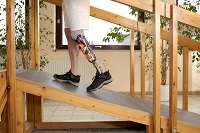
- understanding skin pressures
- problem-solving the fit of the prosthetic socket
- choosing the right footwear
- using other ways to get around, for times when you are not wearing your prosthesis. This is important for
- getting up at night
- when your prosthesis isn’t comfortable or might be causing soreness/pressure
- you might need to give your skin a break during the day.
If prosthetic rehabilitation is successful, access to a wheelchair may still be required for part of your day.
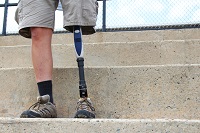
Your ‘definitive prosthesis’
Your definitive prosthesis is designed to last several years. You can decide how your definitive prosthesis will look. Some people choose patterns and designs. Some choose their natural skin tone and shape. Some prefer a foam cover over the prosthesis. Some choose to have the prosthetic components on display. It is an individual and personal choice.
Your new ‘normal’
Adjusting to life after amputation can be challenging. It is important to get back to the things you enjoy in life and find your new ‘normal’.
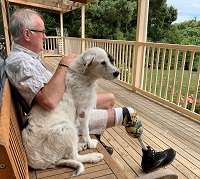
| 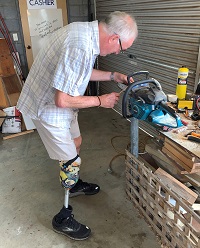
|
